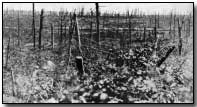Encyclopedia - No Man's Land
 Most commonly associated
with the First World War the phrase "no man's land" actually dates back
until at least the 14th century. Its meaning was clear to all sides:
no man's land represented the area of ground between opposing armies - in
this case, between
trenches.
Most commonly associated
with the First World War the phrase "no man's land" actually dates back
until at least the 14th century. Its meaning was clear to all sides:
no man's land represented the area of ground between opposing armies - in
this case, between
trenches.
For newly arrived novice soldiers No Man's Land held a certain allure. Such troops were cautioned against a natural inclination to peer over the parapet of the trench into No Man's Land. Many men died on their first day in the trenches as a consequence of a precisely aimed sniper's bullet.
The composition of No Man's Land could rapidly change as front lines shifted as a consequence of battles and actions. It was at its most static however along the trenches of the Western Front where from late 1914 until the Spring of 1918 the war was not one of movement but rather one of attrition.
During this period the area of No Man's Land scarcely varied although its width would vary widely from sector to sector, from one kilometre to as little as a few hundred yards (as at Vimy Ridge for example). In the latter instance troops would be able to overhear conversation from their opposing trenches or readily lob grenades into their midst.
No Man's Land was not however barren of activity. During nightfall each side would despatch parties to spy on the enemy, or to repair or extend barbed wire posts. Reconnaissance missions were similarly common. Injured men trapped in No Man's Land would often be brought in under cover of darkness, as were corpses for burial. Consequently artillery shelling of No Man's Land was common, quickly reducing it to a barren wasteland comprised of destroyed vegetation, mud-soaked craters - and rotting corpses.
Photograph courtesy of Photos of the Great War website
'Push' was slang signifying a large-scale attack upon enemy positions.
- Did you know?
